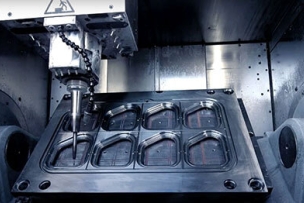Here again, it comes down to data. Proisy describes a more comprehensive digital twin than those available from most machine manufacturers. It contains all of the parameters, machine settings and ladder logic that determine how CNC machine tools react when given commands from the NC program. It is an intelligent twin, rather than the simpler, purely volumetric 3D models on which much of the industry currently relies.
“Whether you’re using our NCSIMUL product or a competing system like Vericut, you need this level of detail to accurately simulate how the machine will react in real life, when you’re actually removing metal,” Proisy says.
Fusion of Technology
Autodesk product manager George Roberts agrees.
“It’s critical that a manufacturing software system accurately represents everything on the shop floor, be it in Autodesk Fusion 360, our CAMplete NC verification solutions or another CAM-focused platform,” he says. “That can be through the lens of G-code post-processing or simulation and verification, but also through machine monitoring and analysis of the resulting data.”
Roberts’ last point—data collection—touches on an enhancement of the digital twin, although it appears to be in its early stages. There’s no shortage of news stories about how equipment-makers have begun to deploy “connected smart products” and gather usage information from the field, analyzing it for predictive maintenance or warranty purposes and using it to improve future product iterations.
The CNC machine tool industry has the same opportunities as other sections of that industry, and the sensor data that fills a shop’s MES (manufacturing execution system) dashboards might also find its way into a lathe or machining center’s digital twin.
“Autodesk is one of many companies investing heavily into digital twin technology,” Roberts says. “Data collection and machine analytics is part of this, which is why we recently acquired technology from CIMCO and Prodsmart for shop floor management and machine monitoring. Machine tools can provide a wealth of data. For example, the operator will want to know whether the machine is running and if there’s a problem such as chatter or an overload situation, while the supervisor might be more interested in broader usage statistics and overall machine performance. I can envision that each of these data sources might be incorporated into the digital twin at some point.”
Get Started with a ‘Small Step’
Rahul Garg, vice president of industrial machinery at Siemens Digital Industries Software agrees with his colleagues about the need for digital twin accuracy and comprehensiveness.
And while he’s a firm believer in using simulation to verify toolpaths, optimize machining processes and avoid crashes, he points out another important use.
“Though not yet widespread, CNC machine tool manufacturers are beginning to utilize the digital twin for some of the analytical and predictive maintenance activities discussed here, but what’s probably more common is its role in training,” Garg says.
“Here, an operator or maybe a repair technician is presented with a virtual representation of the machine control and allowed to see the impact of changes to the programmable logic controller, for instance, or what happens when they invoke a certain G- or M-code. But they’re also using digital twins for job preparation and process planning, all of which serves to increase efficiency in the real world.”
You might be thinking this is all cool stuff for shops with newer machine tools, but what about everyone else? Not to worry, says Garg. For starters, anyone using Siemens NX or any other advanced CAM system already has access to tremendous machine and toolpath simulation capabilities.
And anyone wishing to gather information from older CNC machinery can “easily retrofit” Siemens sensors onto legacy equipment, he says, and use the company’s Industrial Edge to virtualize the entire production floor and capture its data, regardless of machine brand or vintage.
Think your shop is too small for all this technical wizardry? Think again, says Garg. “I strongly believe that these capabilities—from program preparation and toolpath simulation to operator training and process optimization—are especially relevant to the job shops of the world,” he says. “Each is easily leveraged and will improve your overall profitability, reduce defects, and increase throughput. All it takes to get started is a small step in that direction.”






Talk to Us!
Leave a reply
Your email address will not be published. Required fields are marked *